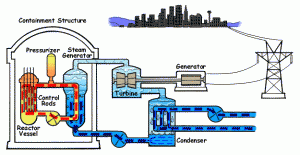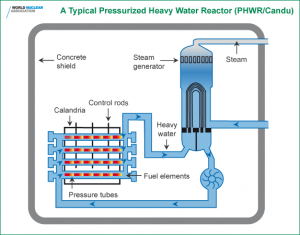Nuclear reactors can be classified into several subsections: power, research, ship-propulsion, production, and specialized reactors.[1] For the scope of this website we will focus on the more commonly used power reactors.
Traditional nuclear reactors used for electricity production are power reactors that use the heat developed from the fission reaction to turn a turbine and run an electric generator as seen in the figure bellow.

The most common form of nuclear reactors are light-water power reactors (LWRs). LWRs are separated into two distinct groups: pressurized-water reactors (PWRs) and boiling-water reactors (BWRs).[2] In both cases the reactors are cooled and moderated using ordinary water and both the LWRs and BWRs are fueled with traditional uranium dioxide pellets in an alloy cladding.[2] Light-water reactors are quiet versatile and can range in size from an electric capacity of 1,000 megawatts to 300 megawatts or less.[1]
A separate type of power reactor design is Canada Deuterium Uranium reactor or CANDU. The CANDU makes use of Canada’s abundant reserves of natural uranium that is moderated and cooled by heavy water.[2] The CANDU reactor operates the same way as traditional LWRs where the heavy water absorbs heat and transfers it into electrical energy. One of the benefits of the CANDU reactor is that the uranium fuel source can be changed while running the system which increases the capacity factor of the plant as seen in the figure below.[2]
Another type of power reactor that have been used for commercial use is the high-temperature gas-cooled reactor. This particular reactor comes in two separate designs, the German pebble bed reactor and the American hexagonal prism design.[1]
(Composed by Ivan Basurto, Edited by Becca McIver & Dan Kervick)
References
1. Nuclear Reactor . 17 April 2015. <http://www.britannica.com/EBchecked/topic/421763/nuclear-reactor/45789/Production-reactors#toc45790>.
2. Nuclear Power Reactor . (2015 , May 3). Retrieved from World Nuclear Association : http://www.world-nuclear.org/info/Nuclear-Fuel-Cycle/Power-Reactors/Nuclear-Power-Reactors/
